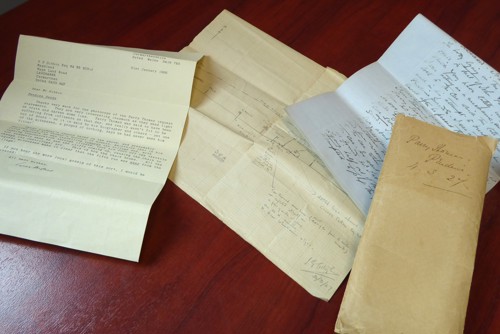Document of the Month
Page updated on: 28/11/2025
Each month we will be showcasing one of the many highlights from within our archive collection.
Title: Stradey Estate Rental, 1767
Reference Numbers: Uncatalogued
Sir Edward Vaughan Mansel, 3rd Baronet, inherited the Mansel baronetcy of Trimsaran, Carmarthenshire, following his father’s passing in 1754.
As a landowner and baronet, he wielded significant influence in the region. The estate rental presented here details the leasing of land, farms, and properties under his stewardship, with tenants paying rent in exchange for occupancy and use.
During the 18th and 19th centuries, estate rentals played a pivotal role in shaping rural Britain's agricultural and economic landscape. Today, they serve as invaluable resources for local historians, offering insights into land ownership, tenancy dynamics, and broader economic conditions of the time.

Title: Llanstephan United A.F.C., 1948-1949
Reference Numbers: CDP/68/1/12
Llansteffan is known for its historic castle, stunning beaches, and vibrant community. But football in Llansteffan also has a strong local presence, with Llansteffan Football Club actively participating in local matches and community events. Over the years, the club has been involved in various fixtures, sponsorships, and seasonal competitions, making it a key part of the local sports scene.
Did you know that Llansteffan also hosts Human Table Football, a unique and engaging activity often featured at team-building events and community gatherings. This life-sized version of table football adds a fun twist to traditional football experiences!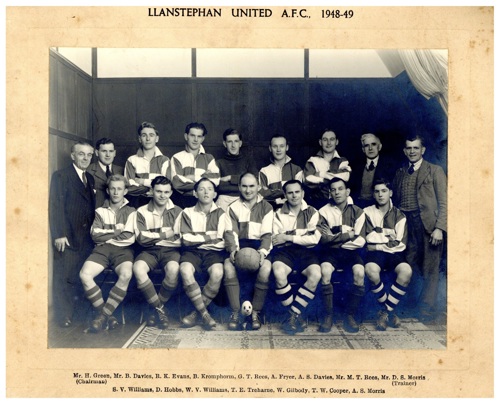
Title: Llanelli YWCA Wartime Memories scrapbook, 1940-1949
Reference Numbers: YWCA/5/1
During the war years, Llanelli YWCA which was located at 14 Mina Street, provided services to various groups of women. Evacuated mothers and their young children were regular visitors to Mina Street, where the children played while mothers could have a cup of tea and a biscuit for a penny and “spend many happy hours together…and forget the horrible experience of losing homes and loved ones”. Many WAAFS, WRNS and members of the Women’s Land Army also visited Llanelli YWCA and took the time to sign the wartime memories scrapbook with messages of thanks for kindness received. Male servicemen were also welcomed and there are thank you notes written by the 1st Belgian Paratroopers.
The scrapbook is full of photographs and messages of those who used the club, which was described as a “Home from home…Happy memories of a haven of rest”.
Miss Bowen is mentioned throughout the scrapbook by the hundreds of visitors who signed it. Florence Alleyne Bowen was born 22 March 1881. She lived with her family in Llanelli and attended a girl’s school in Taunton before returning home to 58 Queen Victoria Road, Llanelli by 1901. Miss Bowen was still living there on the outbreak of war in 1939 by which time she was already active in the Llanelli YWCA movement. Miss Bowen was general secretary of the YWCA in Llanelli for 27 years. She retired in 1952, where she was presented with a travelling clock and cheque as a token of the appreciation felt by past and present members of the association. She died on 17 November 1964.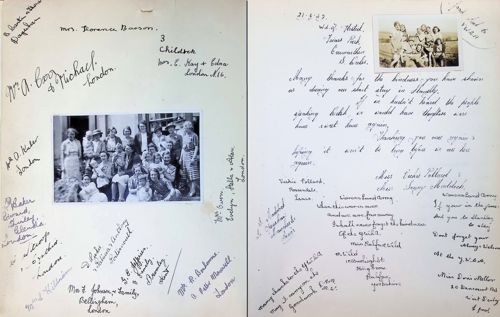
Title: Purging pills and ointments for itches: the records of E. B. Jones & Son
Reference Numbers: DB144/1-2
Carmarthenshire Archives recently received two interesting volumes relating to E. B. Jones & Son, Pharmaceutical Chemists, 16 Lammas Street, Carmarthen. Edward Bowen Jones was born 2 February 1810 and baptised at St Peters, Carmarthen on 5 March 1810. His parents were Daniel and Maria Jones. He married Ann Nicholls in 1833.
Edward was a druggist and had a shop at 16 Lammas Street, Carmarthen between 1841 and his death in 1879. His son Charles William Jones was also a druggist and had premises at 102 Lammas Street in 1871. Edward died aged 69 in 1879 and is buried at Abergwili Parish Church.
The collection consists of two volumes. The first belonged to E. B Jones and includes a copy of recipes of various doctors and farriers in the area. David Owen farmed 50 acres at Nantcwmgwili in the parish of Llanllawddog. His recipes included a strengthening mixture, purging pills and “monthly pills for women” which included the ingredients myrrh and aloe. Lewis David of the Pelican Inn, Bridge Street provided recipes for fever, indigestion and rheumatism. Whereas Thomas Davies of Pant-y-crug offered up ointments for itches and liniments for bruises.
The other volume belonged to Edward’s son Charles William Jones. It is a cash book and records his daily and annual accounts. The volume covers the period 1880-1886 when Charles was operating out of 102 Lammas Street.
The two volumes are available to view in our Searchroom at Carmarthenshire Archives.
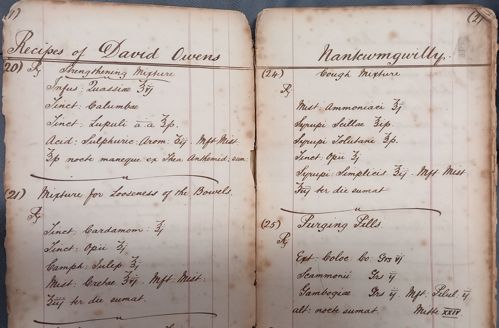
Title: The Goblin’s Moonlight Walk
Reference Numbers: SG55
Written and illustrated by Josepha Heath Gulston of Derwydd Mansion, Llandeilo, under the pseudonym “Talbot Gwynne”, The Goblin’s Moonlight Walk was privately printed in 1844 by the publisher J. Izzard of London.
As a children’s story, the book contains just 9 pages in total (including 6 black and white lithographs). Carmarthenshire Archives holds 5 copies in total, varying in colours including pink, green, beige and blue covers.
The story itself surrounds a mischievous goblin (a small dwarfish man with the head of a cat), and his pestering of “the miller” with whom he finds on his moonlit travels. The moral of the story appears to be that peace is fleeting and that there is always something around the corner - it’s how we adapt ourselves to the situation.
Title: Dorothy Edwards Thomas: Needlework notes, 1916
Reference Numbers: CDX1226/2/1
To celebrate the return of The Great British Sewing Bee, this month’s Document of the Month is a book of needlework notes by Dorothy Edwards Thomas compiled in 1916.
Dorothy was born in 1898 and lived at 12 College Square, Llanelli between 1901 and 1911 with her family.
The volume contains details about various fabrics; a description of each, their use, width of fabric and price. For example, Welsh flannel is described as ‘plain or coloured - pale bluey green, loosely woven, uneven thread, unequalled for wear’. The main use was for making men’s shirts. The cost in 1916 was 1s 6d per yard.
The volume also includes pattern drafting for typical clothing items such as a pinafore dress, overalls, a skirt and camisole. As well as various sewing techniques including buttonholes, seams, tucks, embroidery and gathers.
The original document can be viewed in our Searchroom.
Title: A Humorous Tale of Old Egypt
Reference Numbers: CA22
“Penned down and depicted in the year 1315 a.c. by C. M. Seyppel” – a German portrait painter, caricaturist and writer, 'Sharp, Sharper, Sharpest: A Humorous Tale of Old Egypt' tells the story of the fictional pharaoh Rhampsinit III and his quest to protect his enormous treasure hoard.
Written in “the English tongue of two Mummies of the Old Dynasty”, this satire follows a comic-style format. To add to its style, the paper has been intentionally ripped and coloured to convey aging, tying into the idea that this is a historic account not a recent (c.1882) imagining.
Printed by Felix Bagel, Düsseldorf with the original cloth-backed boards, this is an unusual and interesting early reprise of a satiric comic, however, it is important to note that some of the imagery can now be interpreted as contentious.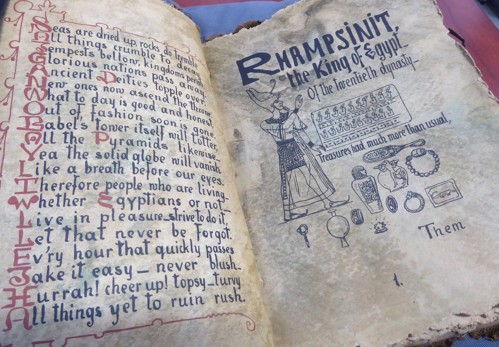
Title: On a roll!
Reference Numbers: D/FJ/8
Written on the reverse of a roll of children’s wrapping paper is what appears to be the family tree of the Powell’s of Maesgwynne, Llanboidy, Carmarthenshire.
Beginning with Rice Powell of the Lampeter Velfrey (Pembrokeshire), then onto Rev. Timothy Powell (1653-1719), and ending with Sarah and Richard Vaughan (c.1942), it just shows that you don’t need any high-tech kit to make a start on your own family history.
Title: Colliery Rescue Team, Tirydail Colliery
Reference Numbers: CDP/4/2/1
This month’s feature is a photograph of the Tirydail Colliery Rescue Team.
Colliery rescue was the specialised job of rescuing miners and others who became trapped or injured in underground mines because of mining accidents.
These brave men who carried out the rescues were specially trained miners who knew the collieries and were familiar with working underground. They would have been trained in using breathing apparatus and specialist rescue equipment and delivering first aid.
Their work was extremely dangerous, and both physically and mentally challenging.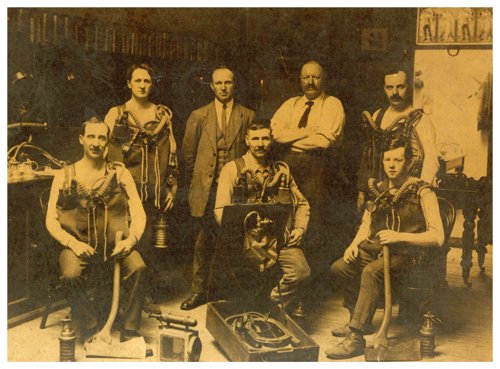
Title: Carmarthen Bank
Reference Numbers: PA/130/5/3
This month’s feature is a document that was used in the case between Waters and Llewellyn.
The case itself was held in late 1826 and seems to have revolved around perceived shortcomings of the Carmarthen Bank which was established by a partnership known as Waters, Jones & Co..
Although the exact details of the case are unknown, it may have been the result of the banking crisis known as the ‘Panic of 1825’. Nevertheless, the document is fascinating because it contains an English translation of the Welsh words spoken by the Defendant, Mr Llewellyn, to a certain Henry Jones.
The bank became bankrupt in 1832.
Title: Love’s Challenges
Reference Numbers: PD4/1/3/5/1 – 9
This month’s item features a series of letters written by James Buckley to Elizabeth Wedge of Penyfai, Llanelli, Carmarthenshire. In the letters James expresses his love for Elizabeth whilst at the same time revealing his anxiety over whether her father will give them permission to marry. In PD4/1/3/5/7 he writes:
“I love you too much to give up without a struggle. Your father is now beginning to give the subject consideration. He has told my father that he will talk with you to know your mind. All will be well if you express your feelings about me to your father.”
The records show that his perseverance paid off as James and Elizabeth were married on the 18th March 1834 at Dafen Parish Church, Llanelli, Carmarthenshire.![Reverse of the letter with a red wax seal that reads “Miss Wedge [Penyvay]”.](/media/uzjnmkfx/reverse-of-letter-with-wax-seal-72dpi.jpg?rmode=max&width=500)
Title: “Mary Christmas” to one and all!
Sources: Llandingat baptism and marriage registers; 1841-1861 census; OS 6” map of Llandovery
To help get us in the mood for Christmas, this month’s documents tell the story of Mary Christmas.
John and Elizabeth Christmas celebrated Christmas early in 1838 when their daughter Mary was born. Mary Christmas was baptised at St Dingat’s Church on 9 December 1838. The family lived at Church Bank, Llandovery between 1841 and 1851. By 1861 Mary was visiting the Davies family at Glan Dulas fach near Taliaris Chapel, Llandeilo Fawr and was working as a dressmaker.
On the 13 September 1867, Mary Christmas married David Jenkins and became Mary Jenkins. The couple continued to live in Llandovery and went on to have seven children.
Title: Picturesque Anatomy
Reference Numbers: Uncatalogued
This month’s feature focuses on the unfinished manuscript “The Anatomy of the Human Figure, Horses and Dogs with an Introduction giving a short view of Picturesque Anatomy”, by Eliza Gulston.
Dated 1796, it could be argued that the subject of anatomy and the human body was improper for female study, however, it seems that Eliza had inherited her passion for the arts and sciences from her mother, Elizabeth Bridgetta Gulston (nee Stepney) – an artist, astronomer, and poet, who also appears to have neglected social norms concerning women of the time and instead pursued her own passions.
Title: Map of Alltyknap, Carmarthen
Reference Numbers: CTC/1/9/2/4/3
This month’s item is one of a series of fantastic maps found in the Carmarthen Town Council records. This colourful example shows land in the parish of St. Peters which was conveyed to a certain Charles Williams by the Borough of Carmarthen in 1765.
Allt-y-Cnap is a hill in Johnstown, Carmarthen – can you find The Ystrad Mansion?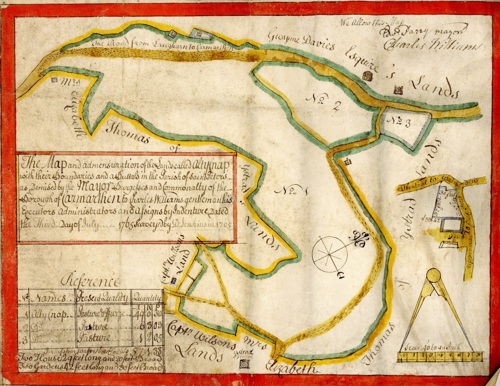
Title: Happy Travels!
Reference Numbers: Derwydd SG44
This ornate photograph album is filled with images seemingly documenting an individual’s trip throughout Egypt and the Near East.
Dated circa 1880, it contains images of historic sites such as the temple of Philae in Aswan, Egypt before its dismantling and relocation to Agilkia Island as well as other famous sites such as the Cairo Citadel, Azbakiya Gardens and the Giza plateau to name a few! 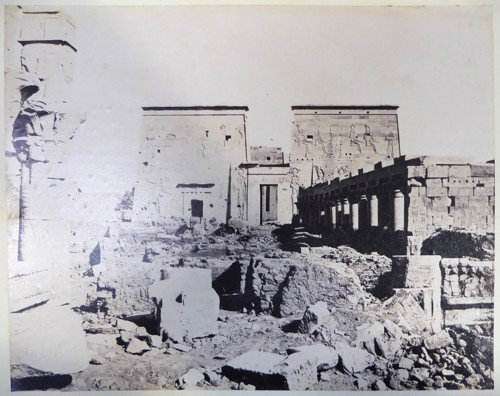
Title: Monsieur Henri Salmet
Reference Numbers: CDX/1157
This month’s document is an autograph album belonging to a young girl named Gwyneth. Unfortunately, we do not know Gwyneth’s surname however this fascinating document includes a short poem dedicated to Henri Salmet.
The poem, written before his flight from Swansea to Llanelly, requests that the famous aviator sign her album which he duly did following the landing of his 50 horsepower Bleriot monoplane at Stradey on Saturday 25th May 1912.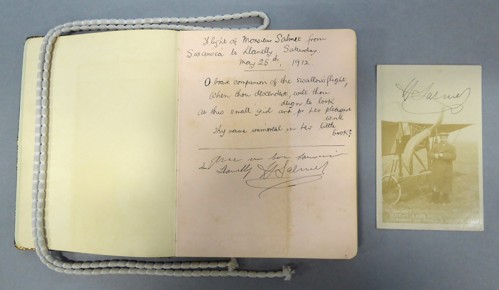
Title: The Flying Welshman
Reference Numbers: CDX/1145
This collection of recently catalogued materials relate to John Godfrey Parry-Thomas, “The Flying Welshman” – the motor-racing driver who fatally crashed in pursuit of the Land Speed record in Pendine, March 1927.
It includes a drawing of Pendine Sands on race day marking the areas in which ‘Babs’ and driver Parry-Thomas fatally crashed, a photocopy of the Parry-Thomas inquest statements, and a letter detailing the matters of inquest held at the Long Room Beach Hotel, Pendine the day after the incident.
Incidentally ‘Babs’, the racing car, was buried in the sands at Pendine shortly after the inquest was held and later recovered in 1969. It has since been restored and is on display at the Museum of Land Speed, Pendine.